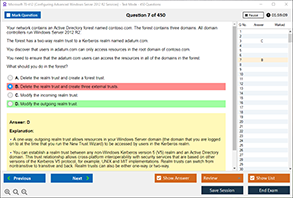Overview of Cisco 200-301 Exam (Cisco Certified Network Associate - CCNA)
The Cisco 200-301 exam, also known as Cisco Certified Network Associate (CCNA), is a foundational certification for networking professionals. It validates a candidate's understanding of core networking concepts, including network access, IP connectivity, IP services, security fundamentals, and automation. The certification is designed to provide a comprehensive understanding of modern networking, equipping professionals with the skills required to install, configure, and troubleshoot small to medium-sized networks.
A major component of the CCNA syllabus focuses on network access and Layer 2 technologies. This is where the Spanning Tree Protocol (STP) becomes an essential topic. STP is integral in preventing loops within Layer 2 networks, ensuring stable and scalable network performance. For candidates preparing for the Cisco 200-301 exam, a deep understanding of STP is vital.
Definition and Purpose of STP
The Spanning Tree Protocol (STP) is a Layer 2 network protocol that ensures a loop-free topology in Ethernet networks. Developed by Dr. Radia Perlman and standardized as IEEE 802.1D, STP was designed to address the problem of network loops that occur in bridged Ethernet environments.
In Layer 2 networks, redundant links are often implemented to provide fault tolerance. However, these redundant links can also introduce switching loops. When a loop occurs, broadcast and multicast traffic can circulate endlessly, consuming bandwidth and degrading network performance. STP prevents these issues by identifying and logically blocking redundant paths until they are needed for failover.
The primary purpose of STP is to:
-
Prevent broadcast storms.
-
Avoid MAC table instability.
-
Maintain a loop-free topology.
-
Provide redundancy and failover mechanisms.
By calculating the most efficient path between switches, STP ensures reliable communication in networks with multiple interconnections.
Common Issues in Scalable Layer 2 Networks
Layer 2 networks are fundamental to enterprise environments, but as they scale, several challenges can arise:
-
Broadcast Storms: In the absence of STP, broadcast packets can circulate indefinitely in a loop, overwhelming the network and leading to denial of service.
-
MAC Address Table Instability: Switching loops can cause MAC addresses to constantly update and change, leading to traffic being misdirected or dropped.
-
Multiple Frame Copies: Redundant links can lead to the same frame being delivered multiple times, causing confusion for the receiving devices and applications.
-
Unpredictable Network Behavior: Without proper loop control, the network can exhibit erratic behavior, making it difficult to diagnose and manage.
-
Resource Exhaustion: Loops and excessive broadcast traffic can exhaust CPU and memory resources on switches.
These issues are particularly prevalent in large-scale networks with complex topologies and redundant paths. Implementing STP helps address these concerns and ensures a scalable and stable network environment.
Core Functions of STP in a Scalable Network
STP operates by selecting a root bridge and then calculating the shortest path from all switches to this root bridge. Based on these calculations, STP places redundant links into a blocking state to prevent loops. The key functions of STP include:
-
Root Bridge Election: STP begins by electing a root bridge using Bridge ID (a combination of priority and MAC address). All path calculations are made relative to this root bridge.
-
Path Cost Calculation: STP assigns a cost to each link based on bandwidth. Lower-cost paths are preferred when determining the shortest route to the root bridge.
-
Port Roles Assignment: STP assigns roles to ports:
-
Root Port (RP): The best path to the root bridge.
-
Designated Port (DP): The forwarding port on a segment.
-
Non-Designated Port (Blocked): Ports that prevent loops.
-
-
Port States: Ports transition through various states (Blocking, Listening, Learning, Forwarding, Disabled) to ensure loops do not form during topology changes.
-
Convergence and Topology Changes: When a link fails or the topology changes, STP recalculates the path to the root bridge and reconfigures port roles accordingly. This convergence process ensures the network adapts to changes without introducing loops.
Benefits of STP in a Scalable Network
STP provides several advantages in managing and maintaining large Layer 2 networks:
-
Loop Prevention: The most critical benefit is preventing switching loops that can disrupt network performance.
-
Redundancy and Failover: STP enables the use of redundant links that can quickly become active if a primary link fails, ensuring network resilience.
-
Optimized Path Selection: STP calculates the most efficient path for data to travel, enhancing network performance.
-
Improved Network Stability: By blocking unnecessary paths, STP maintains a consistent and predictable network state.
-
Scalability: STP enables the expansion of Layer 2 networks without increasing the risk of broadcast storms or other loop-related issues.
-
Interoperability: As an industry-standard protocol, STP works across devices from different vendors, promoting interoperability in multi-vendor environments.
These benefits are especially important for network administrators and engineers managing complex enterprise networks. By mastering STP, professionals can design and maintain networks that are both efficient and reliable.
Related Exam Concepts in Cisco 200-301
The Cisco 200-301 exam includes several objectives related to Layer 2 switching technologies, including STP. Candidates are expected to understand:
-
Basic STP Concepts: The definition, purpose, and operation of STP.
-
STP Port Roles and States: Understanding how ports are assigned roles and transition through states.
-
Root Bridge Selection: How the root bridge is elected and the criteria used.
-
Redundant Topologies: The need for STP in topologies with multiple links and switches.
-
STP Variants: Familiarity with Rapid Spanning Tree Protocol (RSTP) and Multiple Spanning Tree Protocol (MSTP), which are improvements over traditional STP.
-
Network Diagrams and Troubleshooting: Ability to interpret diagrams and troubleshoot STP-related issues.
Mastering these concepts is essential for passing the Cisco 200-301 exam. Practical knowledge of configuring and troubleshooting STP on Cisco devices is also emphasized, highlighting the need for hands-on experience.
Why DumpsBoss is the Ideal Resource for CCNA Preparation
DumpsBoss stands out as a trusted resource for candidates preparing for the Cisco 200-301 exam. Here are the key reasons why DumpsBoss is highly recommended:
-
Updated Exam Dumps: DumpsBoss provides the latest and most accurate exam questions that reflect the current 200-301 exam pattern.
-
Expert-Curated Content: All materials are crafted and reviewed by networking professionals with years of experience.
-
Real Exam Simulations: Practice tests mimic the real exam environment, helping candidates become familiar with the format and time constraints.
-
Topic-Focused Materials: Candidates can access targeted resources focusing on specific topics like STP, routing protocols, IP addressing, and security.
-
Affordable and Accessible: DumpsBoss offers cost-effective solutions for exam preparation, making it accessible to candidates worldwide.
-
Performance Tracking: With interactive practice tests, candidates can track their progress and identify areas that need improvement.
By integrating DumpsBoss into your CCNA study plan, you gain a significant advantage in mastering complex topics such as STP and achieving certification success.
Conclusion
The Cisco 200-301 (CCNA) exam is a critical certification for networking professionals aiming to establish or advance their careers. One of the foundational concepts in the CCNA syllabus is the Spanning Tree Protocol (STP), which plays a vital role in maintaining loop-free and stable Layer 2 networks.
Understanding STP's definition, purpose, functions, and benefits is essential for designing scalable and reliable network topologies. As enterprise networks grow more complex, STP ensures efficient data flow, redundancy, and high availability.
To effectively prepare for the CCNA 200-301 exam and gain hands-on expertise in STP and other core networking concepts, DumpsBoss provides an invaluable resource. With up-to-date exam dumps, detailed explanations, and expert guidance, DumpsBoss empowers candidates to succeed on their first attempt.
For anyone serious about a career in networking, mastering STP and leveraging the resources of DumpsBoss is the perfect combination for success.
Special Discount: Offer Valid For Limited Time “Cisco 200-301 Dumps” Order Now!
Sample Questions for Cisco 200-301 Exam Dumps
Actual exam question from Cisco 200-301 Exam.
What is the function of STP (Spanning Tree Protocol) in a scalable network?
A) To encrypt data packets between devices
B) To prevent loops in network topology
C) To prioritize network traffic
D) To manage IP address assignments



